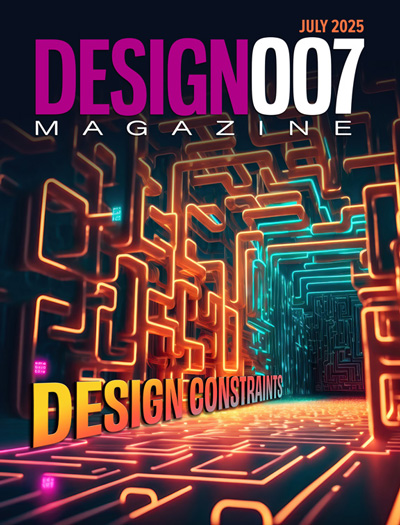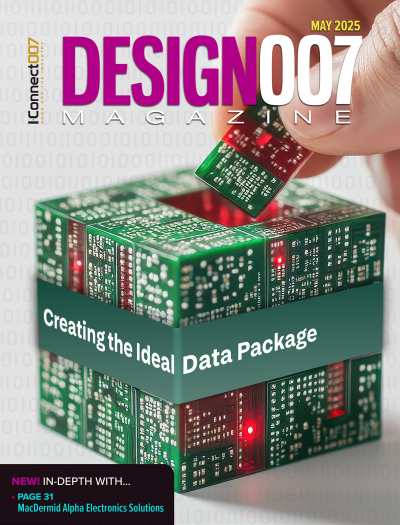-

- News
- Books
Featured Books
- design007 Magazine
Latest Issues
Current Issue
Showing Some Constraint
A strong design constraint strategy carefully balances a wide range of electrical and manufacturing trade-offs. This month, we explore the key requirements, common challenges, and best practices behind building an effective constraint strategy.

All About That Route
Most designers favor manual routing, but today's interactive autorouters may be changing designers' minds by allowing users more direct control. In this issue, our expert contributors discuss a variety of manual and autorouting strategies.

Creating the Ideal Data Package
Why is it so difficult to create the ideal data package? Many of these simple errors can be alleviated by paying attention to detail—and knowing what issues to look out for. So, this month, our experts weigh in on the best practices for creating the ideal design data package for your design.
- Articles
- Columns
- Links
- Media kit
||| MENU - design007 Magazine
ZESTRON South Asia releases whitepaper – Impact of Cleaning Technology on Discrete Packaging - The Difference in Wire Bonding Yield
December 2, 2024 | ZESTRONEstimated reading time: 1 minute
ZESTRON, the global leading provider of high precision cleaning products, services, and training solutions in the electronics manufacturing and semiconductor industries, is pleased to release the whitepaper “Impact of Cleaning Technology on Discrete Packaging - The Difference in Wire Bonding Yield”
Whitepaper Abstract:
Lead frame packages are commonly used in semiconductor package fabrication, where interconnections between the integrated circuits (IC) and the metal leads are typically established through die attach and wire bonding processes. Standard materials like epoxies, adhesives, or solder pastes are most often used in the die attach process. However, it is critical to remove any flux residues left behind after soldering before proceeding with wire bonding and molding to ensure maximum yield in packages that use solder paste for die attachment. One of the most widely used cleaning agents to remove flux residues is isopropyl alcohol (IPA). While IPA is commonly used as a general cleaner in the electronics industry, it is not the most effective solution for flux removal.
Semiconductor package manufacturers produce millions of units daily and therefore, a small improvement in the wire bonding yield can significantly impact production efficiency and the overall product costs.
One such OEM was producing lead frame packages and using IPA (Isopropyl alcohol) in the ultrasonic cleaning process. However, their process resulted in a wire bonding yield of only 98%, measured after the molding and deflashing processes. This indicated significant motivation to improve the cleaning process and the wire bonding yield.
A Design of Experiment (DOE) was developed to assess alternative cleaning agents and process equipment, aiming to optimize the cleaning process and to be evaluated based on the improvement in wire bonding yield. Process qualification was conducted through a pull test according to the MIL-STD-883E method 2011.7. Throughout the DOE process iterations, process improvements were identified through visual inspection, pull and shear testing as well as overall yield measurement from the wire bonding process.
Suggested Items
Digital Twin Concept in Copper Electroplating Process Performance
07/11/2025 | Aga Franczak, Robrecht Belis, Elsyca N.V.PCB manufacturing involves transforming a design into a physical board while meeting specific requirements. Understanding these design specifications is crucial, as they directly impact the PCB's fabrication process, performance, and yield rate. One key design specification is copper thieving—the addition of “dummy” pads across the surface that are plated along with the features designed on the outer layers. The purpose of the process is to provide a uniform distribution of copper across the outer layers to make the plating current density and plating in the holes more uniform.
The Knowledge Base: A Conference for Cleaning and Coating of Mission-critical Electronics
07/08/2025 | Mike Konrad -- Column: The Knowledge BaseIn electronics manufacturing, there’s a dangerous misconception that cleaning and coating are standalone options, that they operate in different lanes, and that one can compensate for the other. Let’s clear that up now. Cleaning and conformal coating are not separate decisions. They are two chapters in the same story—the story of reliability.
SMT007 Magazine July—What’s Your Competitive Sweet Spot?
07/01/2025 | I-Connect007 Editorial TeamAre you in a niche that’s growing or shrinking? Is it time to reassess and refocus? We spotlight companies thriving by redefining or reinforcing their niche—what are their insights? In the July 2025 issue of SMT007 Magazine, we spotlight companies thriving by redefining or reinforcing their niche and offer insights to help you evaluate your own.
Smarter Machines Use AOI to Transform PCB Inspections
06/30/2025 | Marcy LaRont, PCB007 MagazineAs automated optical inspection (AOI) evolves from traditional end-of-process inspections to proactive, in-line solutions, the integration of AI and machine learning is revolutionizing defect reduction and enhancing yields, marking a pivotal shift in how quality is managed in manufacturing.
Magnalytix and Foresite to Host Technical Webinar on SIR Testing and Functional Reliability
06/26/2025 | MAGNALYTIXMagnalytix, in collaboration with Foresite Inc., is pleased to announce an upcoming one-hour Webinar Workshop titled “Comparing SIR IPC B-52 to Umpire 41 Functional & SIR Test Method.” This session will be held on July 24, 2025, and is open to professionals in electronics manufacturing, reliability engineering, and process development seeking insights into new testing standards for climatic reliability.


